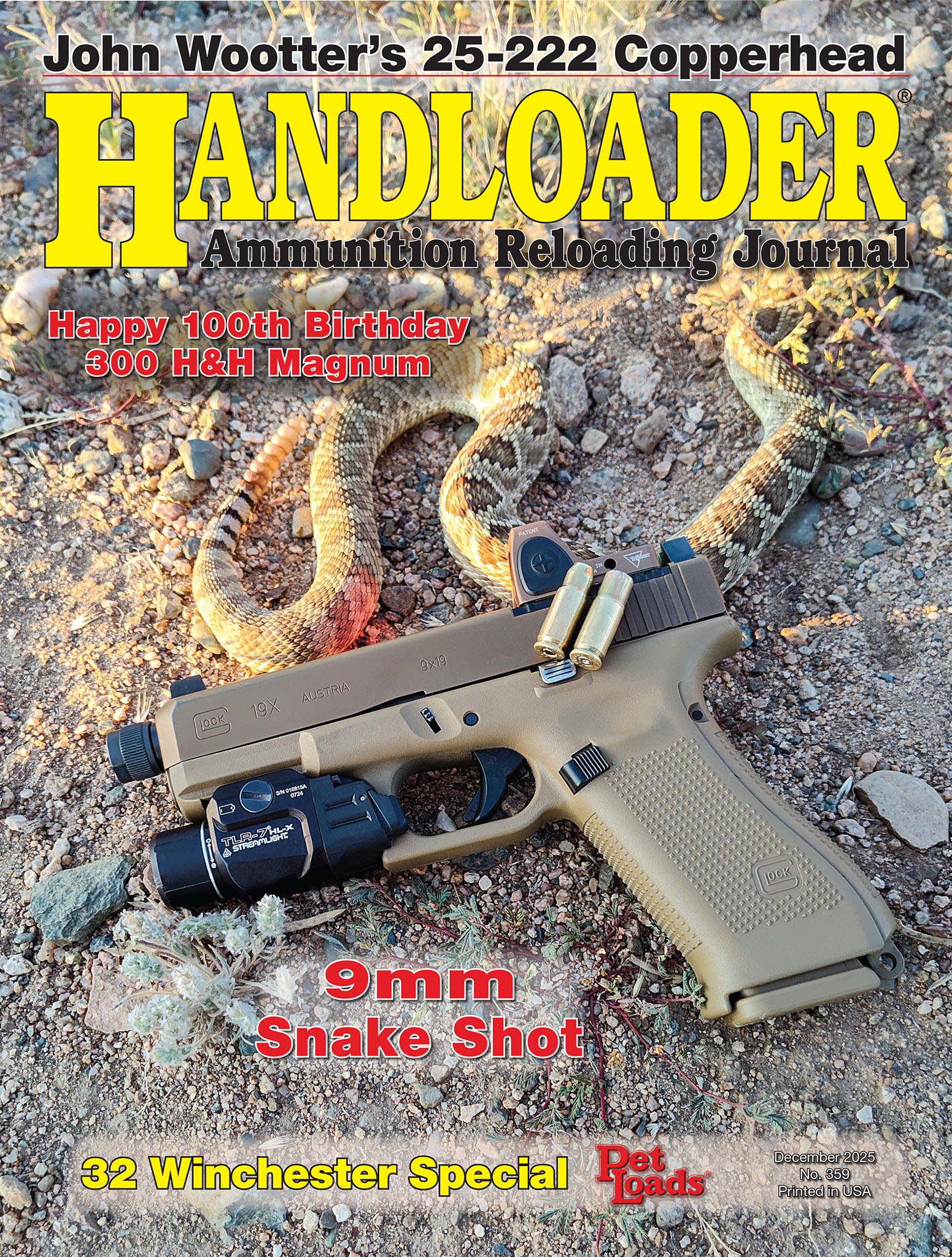For the first time, Lipsey’s teamed with Ruger to offer a New Model Blackhawk Bisley chambered in 41 Magnum. It is built on the medium or 357 flattop style frame, whereas all previous Blackhawks have been built on the large 44 frame. The sample six-gun is accurate, reliable and will make a worthy field companion.
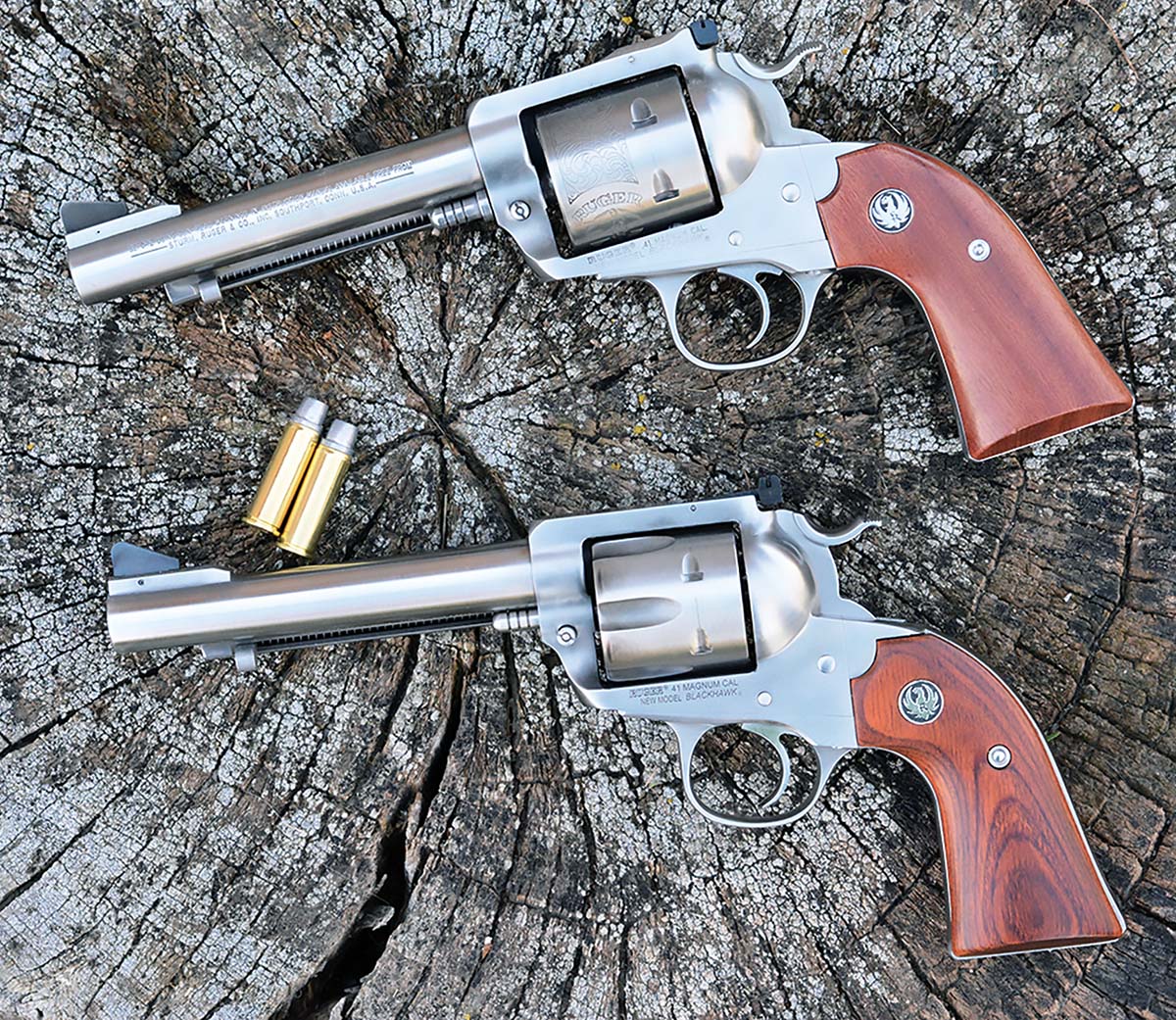
Ruger has traditionally built guns chambered in 41 Magnum on the larger 44-frame (top), but this latest Lipsey’s exclusive is built on the medium-sized 357 flattop frame (bottom).
I have heard from so-called industry “experts” for decades that the 41 Magnum is on the edge of obsolescence and will soon be gone. However, considering the number of gun manufacturers that offer a variety of double- and single-action revolvers and even lever-action rifles, it is safe to say that it is more popular today than at any time in its 61-year history and it is here to stay. While it is true that the 357 and 44 Magnum cartridges enjoy greater popularity, those who use the 41 Magnum often become huge fans of its virtues and advantages. For the record, I greatly enjoy my 41 sixguns, including Smith & Wesson, Ruger, custom Colt SAA’s and even prototype guns. I have hunted big game with them and consider it a truly outstanding cartridge that is often overlooked. If you want an excuse to purchase a new big-bore sixgun, perhaps the 41 Magnum should be considered.

The Early 1950s Ruger 357 Blackhawk (top) shares the same cylinder frame size as the New Model Ruger Blackhawk 41 Magnum (bottom).
The 41 was originally developed at the request of Elmer Keith and Bill Jordan during the 1963 NRA Annual Meetings, with production beginning in 1964. I was fortunate to have known both men. Jordan had been a World War II combat veteran, followed by extensive experience as a Border Patrolman and other law enforcement positions. He was the driving force in getting Smith & Wesson to introduce the 357 Combat Magnum (later known as the Model 19) in 1955. His skill and speed with the double-action sixgun is legendary, but Jordan wanted a larger caliber cartridge to increase effectiveness for law enforcement. Keith was a cowboy, big-game guide, hunter and world-famous gun writer. His dream sixgun cartridge, the 44 Magnum, was developed at his request and first produced in 1955. However, it offered a bit more power and recoil than many lawmen could master. Jordan’s original idea was to have a modern .40-caliber cartridge (the same as the 38-40 Winchester and 41 Colt) but loaded with a 200-grain bullet pushed to 1,200 feet per second (fps) and built on a medium frame double-action sixgun.
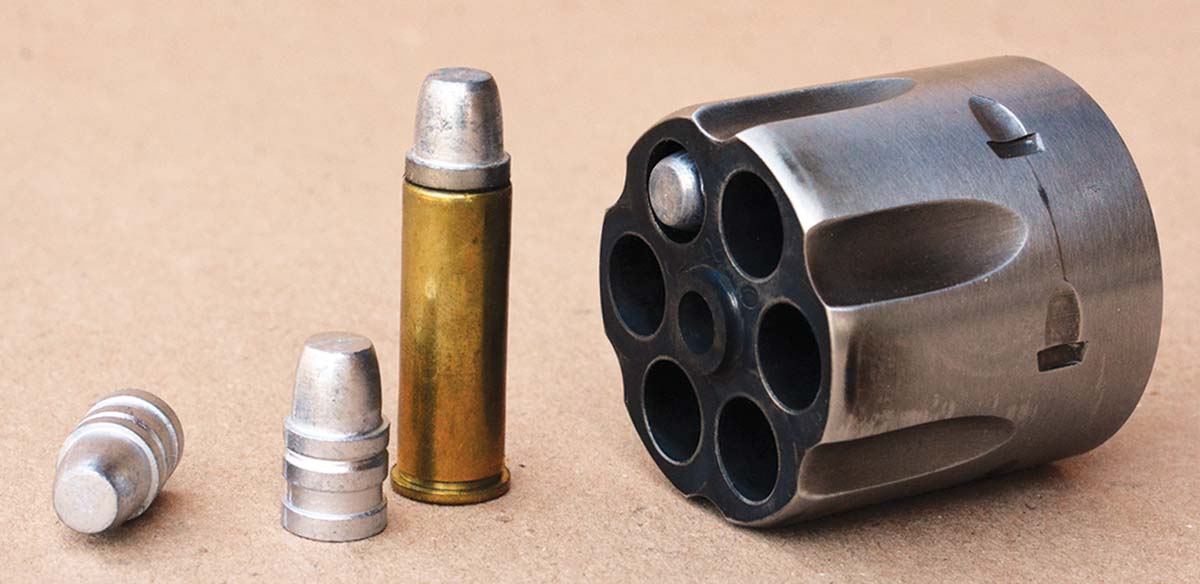
Due to the shorter cylinder length, many traditional 41 Magnum cast bullet loads will protrude out of the cylinder, such as this 223-grain H&G 258 Keith bullet.
Keith and Jordan approached officials at Smith & Wesson and Remington to work together to develop such a cartridge, the same as when they developed the 44 Magnum from 1953 through 1955. Keith and Jordan also cornered Bill Ruger, and he likewise agreed to bring out a single-action sixgun for the new round.
As development of the 41 Remington Magnum progressed, it was decided that using a bullet and bore diameter of .410 inch was necessary to prevent it from being inadvertently fired in antique, black-powder 41 Colt sixguns. This resulted in a totally new case that was not based on any other cartridge. Two loads were initially developed that contained a 210-grain JSP bullet at a listed velocity of 1,500 fps from an 83⁄4-inch barrel (a typo that should have been listed at 83⁄8 inches) and a 210-grain Lead SWC at 1,050 fps. However, from 4- and 6-inch barrels, period loads typically clocked around 1,400 fps and 950 fps, respectively. The idea was that the light load would be the ideal service cartridge load with moderate recoil, big bore reliability and easy to control in fast double-action work and while the heavy load could be used when greater power was needed to stop a vehicle, etc. However, early Smith & Wesson ads were also promoting the 41 Magnum as a big-game hunter and outdoorsman cartridge.
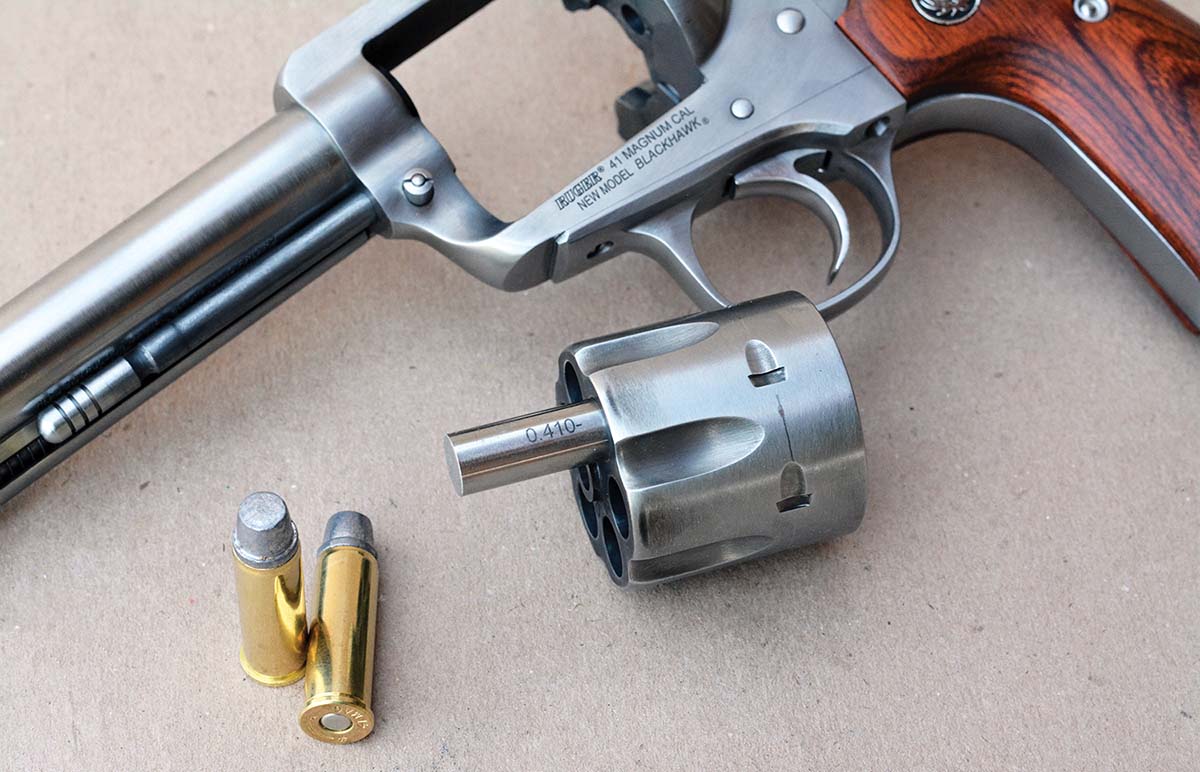
The 41 Magnum boasts of outstanding accuracy. Throats measure .410 inch and that serves to keep bullets straight, helps prevent fusion and aids with accuracy.
While a number of police departments adopted the fixed-sighted Smith & Wesson Model 58 (with some carrying the adjustable-sighted Model 57) chambered in 41 Magnum, its popularity in those circles did not last long. The primary problem was that the Smith & Wesson sixguns were built on the N-frame and externally were the same size as the Model 29 44 Magnum. However, due to the smaller caliber, the weight was actually increased! Many officers felt the added weight was not worth the extra power the cartridge offered and returned to lighter frame sixguns such as the widely popular K-frame Model 19 357 Magnum.
On the other hand, hunters found the new cartridge offered many virtues. The bullet diameter was just .019 to .020 smaller than the 44 Magnum and .053 inch larger than the 357 Magnum. As a result, its terminal performance on game was notably greater than the 357, but not far behind the 44 Magnum. However, recoil is notably less than the 44 Magnums due to its lighter bullet weight.
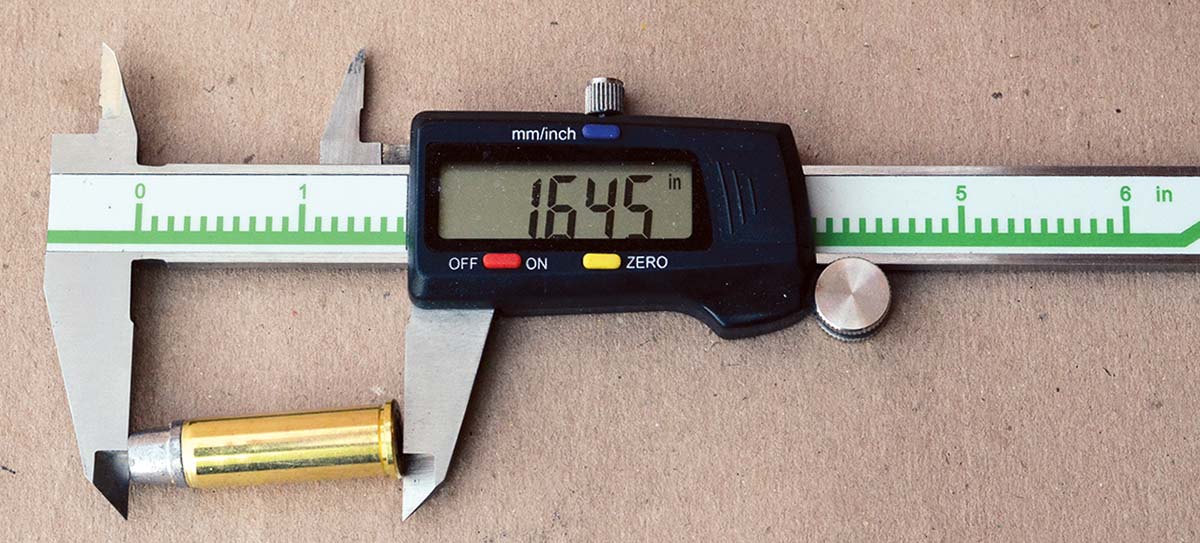
Brian suggests keeping the maximum overall cartridge length at 1.645 inches for 100 percent reliability.
In addition to power, the 41 quickly developed a reputation for outstanding accuracy. For example, the throats of both Smith & Wesson and Ruger Blackhawk revolvers measured very consistently at .410 inch (or just slightly over) and corresponded perfectly with the .410 inch groove and bullet diameter. This minimizes bullet deformation, tilting, fusion, leading, etc., and any reasonable powder and bullet combination generally shoots very well.
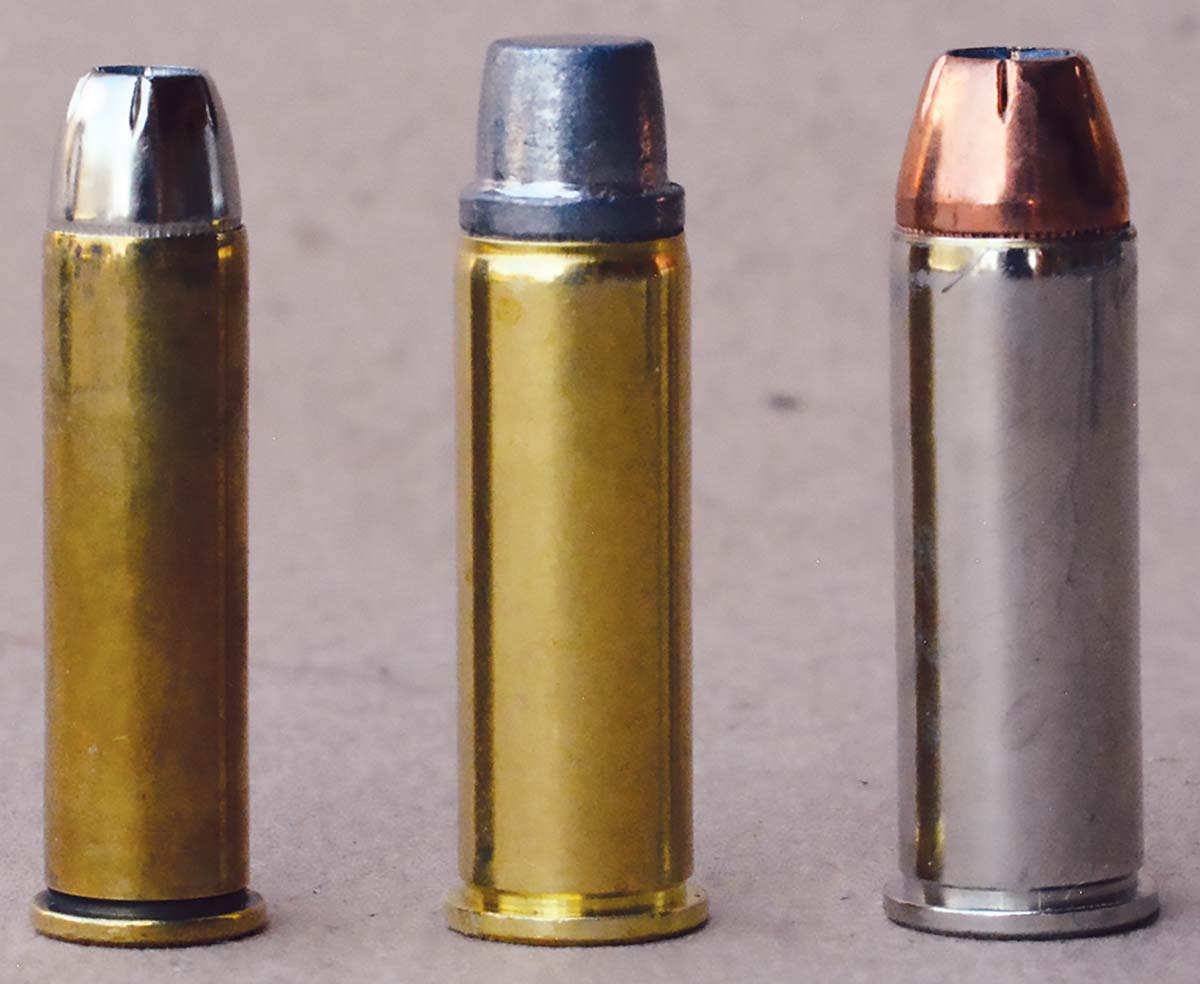
Left to right: 357 Magnum, 41 Magnum and 44 Magnum. The 41 is often referred to as the middle magnum, but its performance is closer to the 44 Magnum – offering greater velocity with bullets of comparable design and notably lower recoil.
As indicated, the Ruger 41 Magnum old model Blackhawk, New Model Blackhawk and all variants have always been built on the large 44-frame. However, this new Lispey’s offering is built on the 357 flattop frame with Micro rear sight and fluted cylinder, making it especially handsome; but it also handles better, is more compact, and the lower axis of the bore reduces felt recoil. Weight is 46 ounces, which is only 2 ounces lighter than a Bisley 41 Magnum with a 51⁄2-inch barrel built on the 44 frame. While the shorter cylinder limits overall cartridge lengths, on a better note, it reduces bullet jump, which generally increases accuracy.
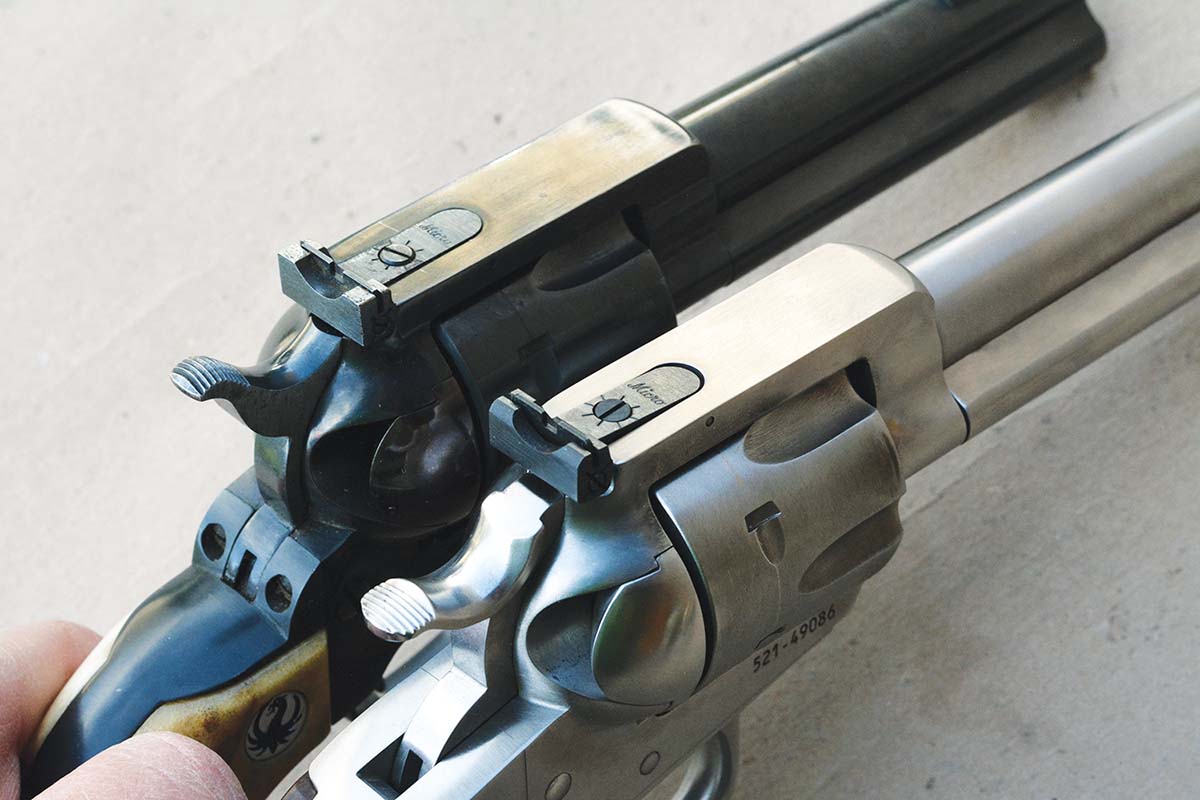
The original Ruger 357 Blackhawk (top) and the new Lipsey’s exclusive New Model Blackhawk 41 Magnum (bottom) each feature a flattop frame with Micro rear sight.
The Ruger Bisley grip frame was influenced by the experimental Keith No. 5 Colt SAA 44 Special, which was built in the 1920s. It is extremely comfortable when dealing with heavy recoil. Even with the heaviest 41 loads, the gun is easy to manage without discomfort during long shooting sessions.
The sample gun features a 51⁄2-inch barrel, red laminated wood grips and a staked black front sight blade that is tall enough to allow easy sight in with all bullets, including heavyweights. The barrel cylinder gap is .006-inch, chambers all range perfectly and cylinder end shake is modest. The throats measure .410-inch. The overall fit and finish is good, especially considering the gun’s modest price tag. Typical of modern Ruger revolvers, the trigger pull is a bit heavy at 5.1 pounds, but that is easily corrected.
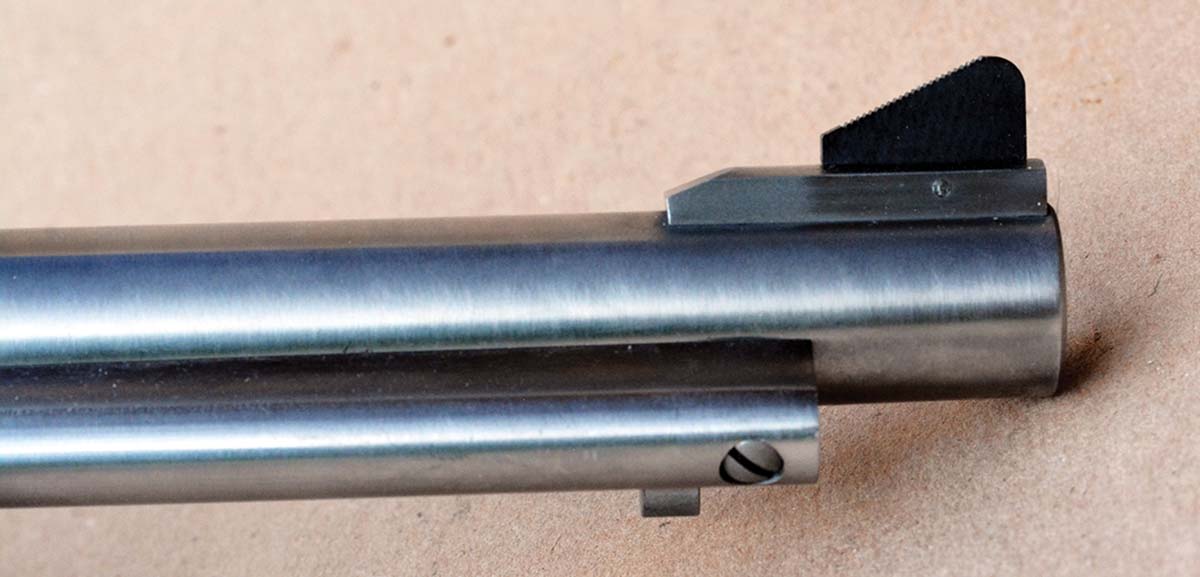
Both stainless-steel and blue-finished guns will feature a staked front sight that allows the blade to be changed.
Today’s factory loads from Remington list a 210-grain JSP at 1,300 fps. Winchester offers two interesting loads that include a 175-grain Silvertip HP and a 240-grain Platinum Tip, each at 1,250 fps. Federal lists the 210-grain Swift A-Frame at 1,360 fps. Generally speaking, factories push 210-grain jacketed 41 loads around 100 fps faster when compared to 44 Magnum loads with 240-grain jacketed bullets (with both bullets sharing similar ballistic coefficient (BC) and sectional density). The original “Police” Lead SWC at 1,050 fps has long since been discontinued; however, handloaders can easily duplicate its ballistics and improve accuracy. The light recoil is great for target work, but is still potent enough for defense and even hunting.
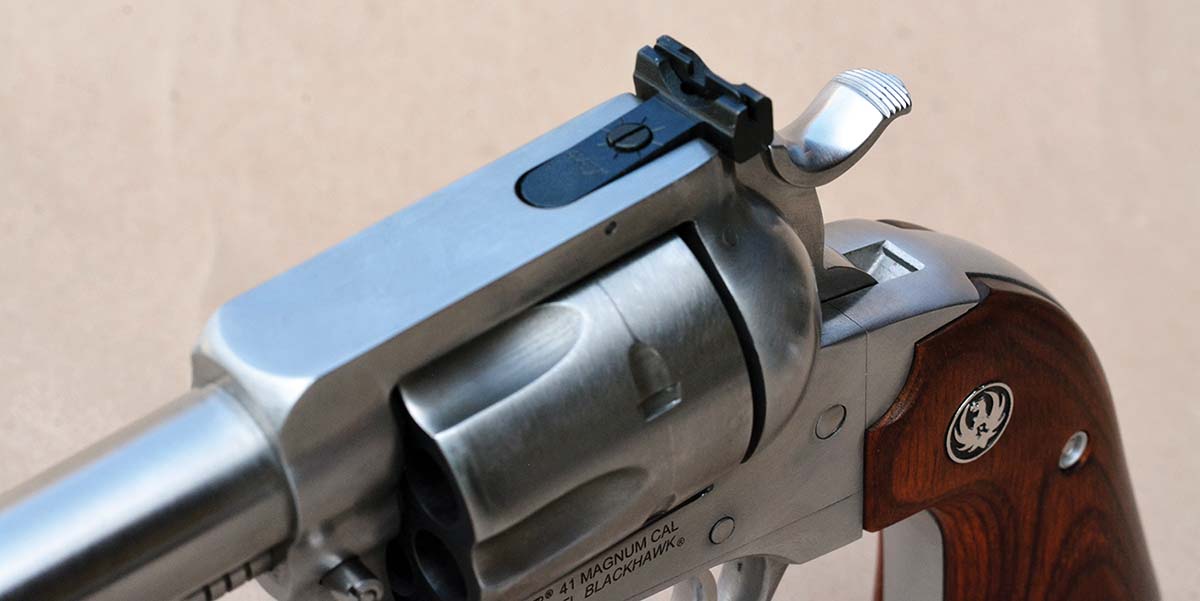
The Micro rear sight is fully adjustable for windage and elevation.
There are several non-SAAMI (Sporting Ams and Ammunition Manufacturers’ Institute) companies that offer specialized 41 loads that often contain cast bullets and increase overall performance. However, some cartridges will exceed the allowable overall cartridge length of 1.658 inches of this new 41 Magnum New Model Blackhawk built on the 357 frame. However, in the event that bullets move or walk out of the case slightly during recoil and the cartridge length “grows,” it is suggested to keep the maximum cartridge overall length (COAL) around 1.645 inches or less. Incidentally, the maximum industry COAL is 1.590 inches.
With the aid of a sandbag rest, Federal and Remington 210-grain jacketed loads grouped into 1.40 and 1.25 inches, respectively, at 25 yards. The only other suitable factory load on hand at press time is the Buffalo Bore 230-grain cast Outdoorsman SWC listed at 1,450 fps. This load offers power and deep penetration, and grouped into 1.30 inches.
Moving on to handloads containing both jacketed and cast bullets, several loads were tried. Elmer Keith endorsed the Hensley & Gibbs No. 258 bullet mould, which casts bullets from my alloy at 223 grains. (Note: The following comments also apply to the 221-grain Lyman Keith mould 410459.) When seated and crimped in the crimp groove, the overall cartridge length is 1.700 inches, which is too long for this sixgun. Some will suggest using the Starline 41 Special case in conjunction with the Keith bullet. However, for several reasons, I’m not a big fan of using special length cases in magnum chambers. There are other options for the above bullets that include taper crimping into the front driving band for an overall cartridge length of 1.645 inches, but most readers will not have access to the custom 41 taper crimp die that I made. As long as cases are perfectly uniform in length and bullets are seated in a separate step from crimping, a roll crimp will also work. The best option is to seat bullets with the front driving band inside the case, which results in an overall cartridge length of 1.600 inches. This provides better bullet alignment with the axis of the bore when compared to loads assembled in the special case and usually gives better accuracy. Naturally, this reduces powder capacity, and maximum powder charges will necessarily need to be reduced accordingly.
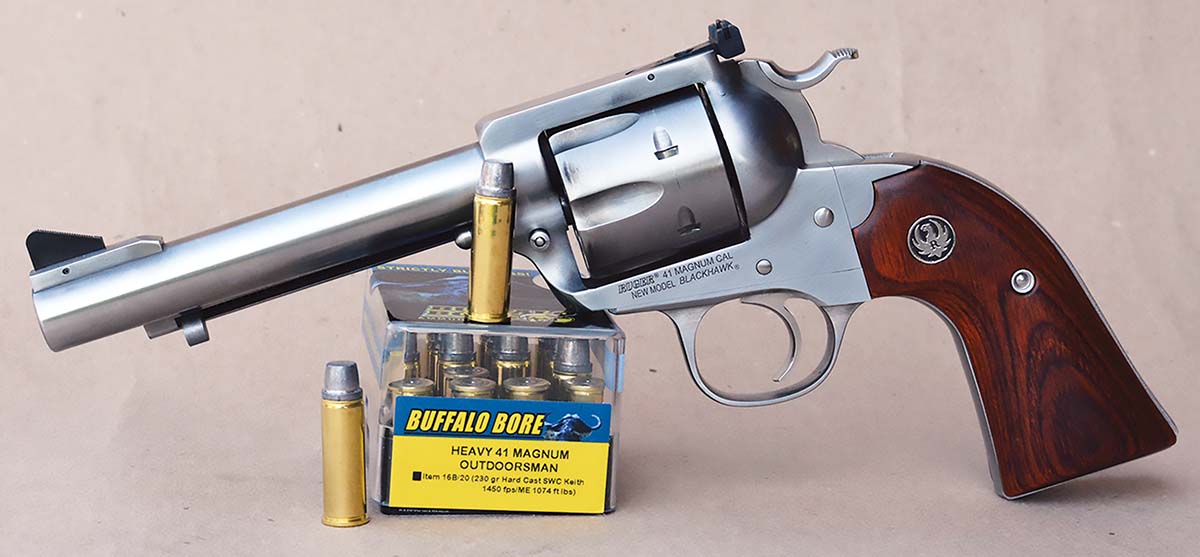
The Ruger New Model Blackhawk Bisley 41 Magnum is built on the 357 flattop frame and is available in blue or stainless steel.
As can be seen in the accompanying table, good accuracy was obtained with handloads. New
Starline cases were full-length sized, neck expanded and then capped with CCI 300 standard large pistol primers for all loads. Most loads with both cast and jacketed bullets grouped into 1- to 1 1⁄2-inches at 25 yards, illustrating the consistent accuracy of the 41. However, several loads managed to group under 1 inch (average of three groups, five shots each).
For example, the 180-grain Cutting Edge Raptor HP reached just over 1,400 fps using 12.5 grains of Hodgdon Longshot powder and grouped into .90 inch. The Cutting Edge 220-grain solid reached 1,266 fps using 14.5 grains of Accurate No. 7 powder and clustered into ragged holes measuring just .70 inch. Switching to the 223-grain Keith bullet from Hensley & Gibbs No. 258 mould, 6.0 grains of Accurate No. 2 reached 917 fps, and groups averaged .95 inch. Using the 230-grain Rim Rock SWC w/gc bullet, 21.0 grains of Accurate No. 11FS (1,399 fps), 18.0 grains of Accurate No. 9 (1,394 fps), and 11.0 grains of Accurate No. 5 (1,185 fps) each showed the potential of sub-1-inch groups.
Shortly after Ruger reintroduced the 357 flattop frame in 2005 (for the 50th Anniversary Blackhawk), Lipsey’s Jason Cloessner discussed the idea of adding other calibers on that frame size. This conversation resulted in the 44 Special and later the 45 Colt/45 ACP, but I also encouraged him to add the 41 Magnum. That was almost 20 years ago, and it has been worth the wait! Many test guns pass through my hands and are then returned to the manufacturer, but I’m going to send a check for this new medium frame 41 Magnum, as it’s a keeper! By the time you read these words, a blue steel version will be available, followed by a 4 5⁄8-inch barrel and an XR3-style steel grip frame. I am also encouraging an alloy XR3 grip frame for a lightweight version. Regardless, this 41 sixgun offers reliability, accuracy and power.
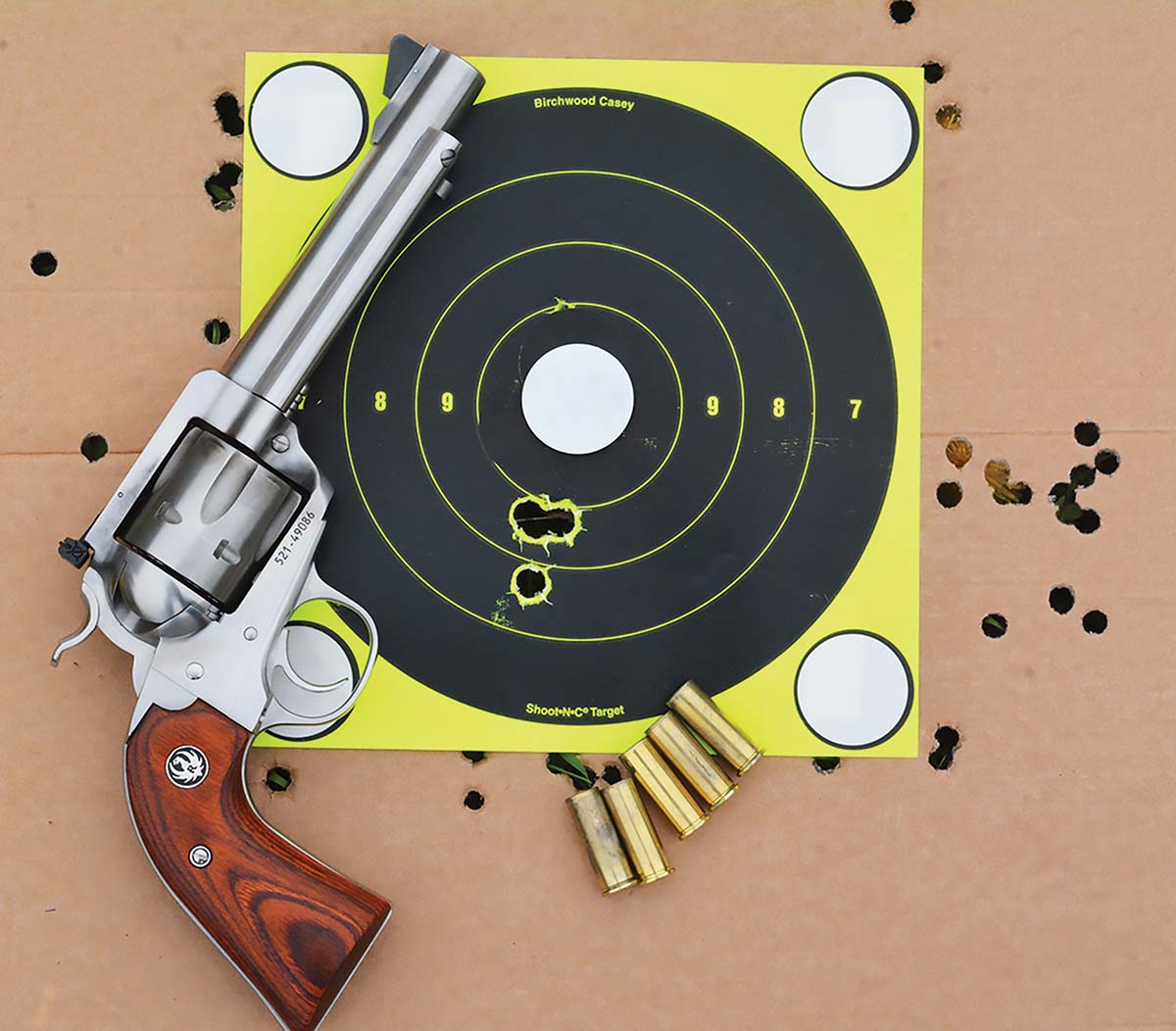
The Ruger New Model Blackhawk Bisley produced excellent accuracy at 25 yards.
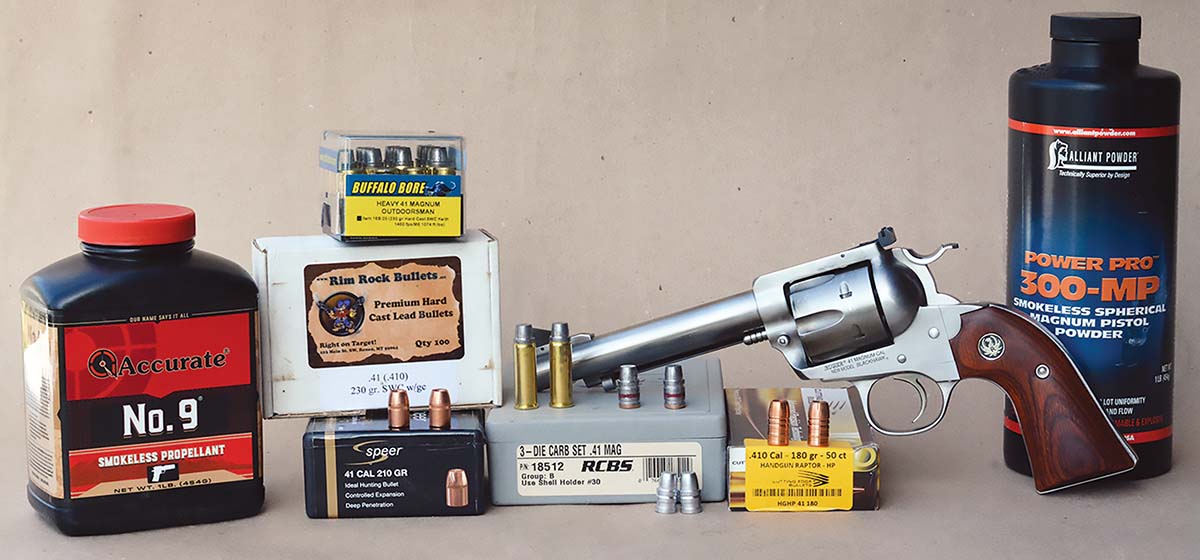











.jpg)
.jpg)
.jpg)


